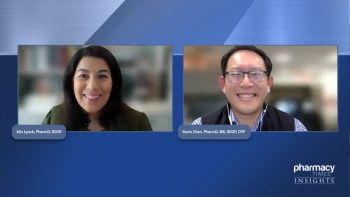
Determining Intensive Chemotherapy Eligibility in AML
Two medical professionals reveal what factors into intensive chemotherapy consideration and common toxicities found when undergoing treatment.
Episodes in this series

Ryan Haumschild, PharmD, MS, MBA: Let's continue to talk about some of the goals and current trends in the management of these patients when we specifically talk about treatment. What I want to delve into, Dr. McCloskey, are the factors that you take into consideration. Is a patient fit enough for chemotherapy? What does that process look like? What's that evaluation, and how does that conversation go with the patient?
James McCloskey, MD: This is one of the areas in AML [acute myeloid leukemia] that remains rather subjective, and we have tried to develop a variety of tools to assist us in assessing a patient's fitness. They have been disappointing, not terribly useful for every day clinical practice. The patient's comorbidities and organ functions are easy to assess and are objective, but a lot of the more important things are the subjective assessment. A lot of valuable information can come from assessing what their day-to-day activities are like. Are they taking care of their own home? Are they doing their own grocery shopping, and do they have limitations there? Along with that comes important considerations around their social support. As Danielle mentioned, it takes a village to get patients through induction and consolidation. We need to understand what their caregiver situation is and what their social situation is when we're planning this. Lastly, their values and what their goals are from treatment.
Ryan Haumschild, PharmD, MS, MBA: When we're determining how fit a patient is, I'm imagining the toxicity has to come into play. We've got to make sure patients can handle the adverse events. When I talk with my payers, they're concerned about total cost of care. How are we going to manage length of stay, to make sure that [the] patient can stay durable enough for the entire treatment? Dr. McCoy, can you mention what some of those toxicities are that are associated with this chemotherapy in the first-line setting?
Cole McCoy, MD: When you pick a certain drug regimen, you fit them in different buckets. If they are fit enough for induction, they're going to get something more like traditional chemotherapy—your anthracyclines, analogs, those kinds of medications. There are also your targeted therapies, which have more unique characteristics. Going back to those more traditional chemotherapies, some of the toxicities that we're going to be monitoring is patients are going to be myelosuppressed. They're going to be neutropenic with a high risk for infection. They're going to be on supportive care medications to prevent against infection. They will be anemic, so they're going to receive several different red blood cell transfusions, as well as thrombocytopenic so platelets are low. They'll receive some platelet transfusions as well, and that could last up to 2 or 3 weeks. [We’re going to be monitoring myelosuppression in the more traditional sense]. Other things, especially these more intense chemotherapies that we get, kill your fast growing cells, so these patients can have enterocolitis, diarrhea, those kinds of things that we're going to be monitoring throughout.
Moving on, if we're adding any specific targeted agents, each targeted agent is going to have specific monitoring and toxicities that we watch out for. Before, I mentioned midostaurin, the FLT3 inhibitor that we add to 7 and 3. Some unique monitoring that we do is QT [cardiac repolarization] monitoring, and these patients are often on an antifungal or an antibiotic that also prolongs the QT. They're on antiemetics that prolong the QT and still have something in the package labeling that we have to watch out for. We talked about the gemtuzumab ozogamicin having a risk for hepatotoxicity or veno-occlusive disease. We monitor those LFTs [liver function tests] closely, so [we have to look out for specific toxicities for those targeted agents]. Traditional chemotherapy is more of that myelosuppression anemia and thrombocytopenia.
Ryan Haumschild, PharmD, MS, MBA: There are a lot of adverse events, but with that comes great therapy. That's why when we build out our treatment pathways and our order sets, we're always trying to be thoughtful of those different parameters. Making sure we're checking any type of dose reductions or monitoring that's needed becomes an important piece of care, especially for the first-line patients.
This transcript has been edited for clarity.
Newsletter
Stay informed on drug updates, treatment guidelines, and pharmacy practice trends—subscribe to Pharmacy Times for weekly clinical insights.




